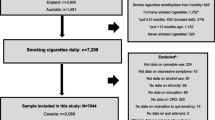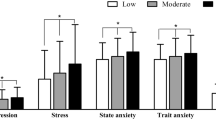Abstract
The most popular measure of tobacco dependence, the Fagerstrom Tolerance Questionnaire (FTQ), measures only tobacco-specific behaviors. In contrast, the most popular assessment of addiction among polydrug users is the Addiction Severity Index (ASI). Most of the subscales comprising the ASI are psychosocial measures, not drug-specific measures. A study was undertaken to compare the predictive utility of these two contrasting measures. The NAS (adapted from the FTQ) and the Addiction Severity Index (ASI) were used to predict future smoking status in a cohort of polydrug users followed annually for 3 years. The baseline NAS score explained more of the variance in Time 2 and Time 3 smoking status than did the ASI subscales. When previous smoking status was included as a covariate, however, the NAS no longer predicted future smoking status, whereas the ASI Subscales continued to explain significant variance in future smoking status. Results suggest that when past smoking behavior is known, a respondent's legal status and alcohol use may be more useful than a measure of tobacco dependence for predicting future smoking status.
Similar content being viewed by others
REFERENCES
Alterman, A. J., Cook, T. G., Metzger, D., Rutherford, M. J., Cacciola, J. S., McDermott, P. A., and Brown, L. S. (1998). New scales to assess change in the Addiction Severity Index for the opioid, cocaine, and alcohol dependent. Psychol. Addict. Behav. 12: 233–246.
American Psychiatric Association (1994). Diagnostic and Statistical Manual of Mental Disorders: DSM-IV, 4th ed., American Psychiatric Association, Washington, DC.
Baer, J. S., Holt, C. S., and Lichtenstein, E. (1986). Self-efficacy and smoking reexamined-Construct validity and clinical utility. J. Consult. Clin. Psychol. 54: 846–852.
Bentler, P. M., and Speckart, G. (1979). Models of attitude-behavior relations. Psychol. Rev. 86: 452–464.
Cigarette Smoking Among Adults-United States, 1995 (1997). Morbid. Mortal. Week. Rep. 46: 1217–1220.
Cohen, J., and Cohen, P. (1983). Applied Multiple Regression/Correlation Analysis for the Behavioral Sciences, Erlbaum, Hillsdale, NJ.
DiMatteo, M. R., Sherbourne, C. D., Hays, R. D., Ordway, L., Kravitz, R. L., McGlynn, E. A., Kaplan, S., and Rogers, W. H. (1993). Physicians' characteristics influence patients adherence to medical treatment-Results from the medical outcomes study. Health Psychol. 12: 93–102.
Fagerstrom, K. O., and Schneider, N. G. (1989). Measuring nicotine dependence: A review of the Fagerstrom Tolerance Questionnaire. J. Behav. Med. 12: 159–182.
Fiore, M. C., Jorenby, D. E., and Baker, T. B. (1997). Smoking cessation: Principles and practice based upon the AHCPR Guideline, 1996. Agency for Health Care Policy and Research. Ann. Behav. Med. 19: 213–219.
Henningfield, J. E. (1995). Nicotine medications for smoking cessation. N. Engl. J. Med. 333: 1196–1203.
Henningfield, J. E., Benowitz, N. L., Slade, J., Houston, T. P., Davis, R. M., and Deitchman, S. D. (1998). Reducing the addictiveness of cigarettes. Council on Scientific Affairs, American Medical Association. Tobacco Control 7: 281–293.
Hodgins, D. C., and el-Guebaly, N. (1992). More data on the Addiction Severity Index. Reliability and validity with the mentally ill substance abuser. J. Nerv. Ment. Dis. 180: 197–201.
Hourani, L. L., Yuan, H., Bray, R. M., and Vincus, A. A. (1999). Psychosocial correlates of nicotine dependence among men and women in the U.S. naval services. Addict. Behav. 24: 521–536.
Hser, Y., Boyle, K., and Anglin, M. D. (1998). Drug use and correlates among sexually transmitted disease patients, emergency room patients, and arrestees. J. Drug Issues 28: 437–454.
Jorenby, D. E., Leischow, S. J., Nides, M. A., et al. (1999). A controlled trial of sustained-release bupropion, a nicotine patch, or both for smoking cessation. N. Engl. J. Med. 340: 685–691.
Kawakami, N., Takatsuka, N., Inaba, S., and Shimizu, H. (1999). Development of a screening questionnaire for tobacco/nicotine dependence according to ICD-10, DSM-III-R, and DSM-IV. Addict. Behav. 24: 155–166.
Lichtenstein, E., and Mermelstein, R. J. (1986). Some methodological cautions in the use of tolerance questionnaire. Addict. Behav. 13: 87–90.
McCarthy, W. J., Zhou, Y., and Hser, Y-I. (2000). Individual change amid stable smoking patterns in polydrug users over 3 years. Addict Behav. (in press).
McLellan, A. T., Luborsky, L., Cacciola, J., Griffith, J., McGahan, P., and O' Brien, C. P. (1985). Guide to the Addiction Severity Index: Background, Administration and Field Testing Results, USDHHS, PHS, ADAMHA, Rockville, MD.
McLellan, A. T., Kushner, H., Metzger, D., Peters, R., Smith, I., Grissom, G., Pettinati, H., and Argeriou, M. (1992). The Fifth Edition of the Addiction Severity Index. J. Substance Abuse Treat. 9: 199–213.
Miller, V. P., Ernst, C., and Collin, F. (1999). Smoking-attributable medical care costs in the USA. Soc. Sci. Med. 48: 375–391.
Mossman, D. (1994). Assessing predictions of violence: being accurate about accuracy. J. Consult. Clin. Psychol. 62: 783–792.
Murray, R. P., Gerald, L. B., Lindgren, P. G., Connett, J. E., Rand, C. S., and Anthonisen, N. R. (2000). Characteristics of participants who stop smoking and sustain abstinence for 1 and 5 years in the Lung Health Study. Prev. Med. 30: 392–400.
Nunnally, J. C. (1978). Psychometric Theory, 2nd ed., McGraw-Hill, New York.
Prokhorov, A. V., De Moor, C., Pallonen, U. E., Hudmon, K. S., Koehly, L., and Hu, S. (2000). Validation of the modified Fagerstrom tolerance questionnaire with salivary cotinine among adolescents. Addict. Behav. 25: 429–433.
Stillman, F., Hartman, A., Graubard, B., Gilpin, E., Chavis, D., Garcia, J., Wun, L.-M., Lynn, W., and Manley, M. (1999). The American stop smoking intervention study: Conceptual framework and evaluation design. Eval. Rev. 23: 259–280.
Rights and permissions
About this article
Cite this article
McCarthy, W.J., Zhou, Y. & Hser, YI. Psychosocial Versus Nicotine-Only Self-Report Measures for Predicting Follow-Up Smoking Status. J Behav Med 24, 75–91 (2001). https://doi.org/10.1023/A:1005638521562
Issue Date:
DOI: https://doi.org/10.1023/A:1005638521562




